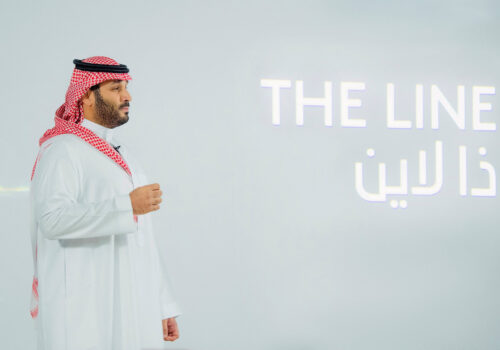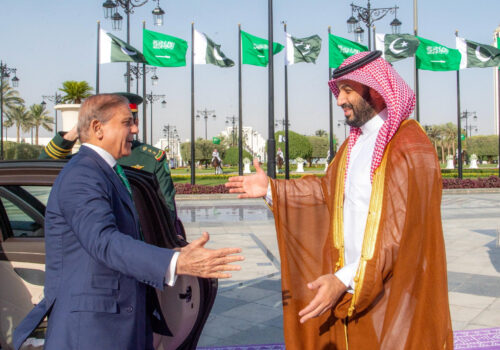Saudi Arabia’s next horizon: Building human capital beyond Vision 2030
Former US Secretary of State Dean Acheson, one of the leading intellectuals of the twentieth century and a founder of the Atlantic Council, is attributed with saying, “always remember that the future comes one day at a time.” But based on meetings this week with US President Donald Trump and Saudi Crown Prince Mohammed bin Salman (MBS), the future for the Kingdom of Saudi Arabia appears to be arriving all at once.
The kingdom is committing one trillion dollars of investments to the United States while receiving advanced US technologies such as next-generation semiconductors, AI-driven data infrastructure, energy systems, and even civilian nuclear technology.
The critical question is whether Saudi Arabia can simultaneously be a net importer and exporter of capital, new technologies, energy, ideas, and talent, while producing accretive financial results and a sustainable society.
Saudi Arabia is approaching the tenth anniversary of Vision 2030, a sweeping reimagining of its economic and social identity built on three pillars: a vibrant society, a thriving economy, and an ambitious nation. As the ten-year milestone approaches, it is worth reflecting on how far the kingdom has come and what lies beyond the horizon. At the heart of Vision 2030 was a bold commitment: to diversify away from an overreliance on hydrocarbons and to build an economy that is more resilient, innovative, and equitable.
The results have been substantial, though challenges remain.
According to the International Monetary Fund (IMF), non-oil real gross domestic product (GDP) grew 4.5 percent in 2024, driven by sectors such as retail, hospitality, and construction. In the IMF’s most recent country report, after GDP rebasing, the non-oil economy now accounts for roughly 76 percent of total GDP—a major structural shift. The World Bank similarly highlights a dramatic rise in women’s economic participation. Female labor force participation increased from 17.4 percent in 2017 to around 36 percent by the first quarter of 2023, with reforms under Vision 2030 cited as a key driver.
Yet Riyadh still needs to take critical steps to foster a deeper culture of risk-taking and to fully support small and medium-sized enterprises, the true engines of job creation. As emphasized at the US–Saudi Investment Forum by leaders including Steve Schwarzman (chief executive officer and co-founder of Blackstone) and Michael Milken, another priority is the development of a stronger domestic capital market. To assess risk and returns effectively, investors require greater transparency, reliable financial reporting, and consistent rule of law—elements essential to attracting sustained private investment at scale.
Economic progress and the next frontier
According to the IMF, Saudi Arabia’s economy continued to grow in 2024 despite global volatility, expanding 1.3 percent and supported by stronger non-oil activity. Non-oil sectors grew 4.3 percent in 2024, reinforcing long-term diversification momentum. Saudi Arabia’s digital economy has accelerated significantly, with information and communication technology now estimated at 15.6 percent of GDP, according to the General Authority for Statistics. Tourism is emerging as a major non-oil contributor. Vision 2030 targets tourism at 10 percent of GDP and 1.6 million jobs by 2030, according to official Vision 2030 reporting and the Tourism Development Fund.
Foreign direct investment (FDI) has also been rising. Vision 2030 sets a target of FDI equal to 5.7 percent of GDP, and Ministry of Investment reporting indicates continued growth.
Saudi Arabia’s next phase of growth is increasingly shaped by knowledge and technology-based industries, including artificial intelligence, fintech, biotechnology, next-generation energy, and advanced computing. The kingdom combines several strategic advantages: low-cost energy, deep capital reserves, abundant industrial land, and a rapidly improving regulatory environment for foreign investors. These conditions are accelerating the development of domestic intellectual capital through joint ventures, research partnerships, and structured global knowledge transfer.
At the US–Saudi Investment Forum this week, Elon Musk announced that xAI will build a large-scale data center in the kingdom in partnership with Humain, a Saudi artificial intelligence company. With a five-hundred-megawatt power requirement, the data center would be xAI’s largest facility outside the United States. At the same forum, Schwarzman announced plans to develop AI data centers in Saudi Arabia in partnership with Blackstone-backed company AirTrunk, using Nvidia AI chips. In the opposite direction, Saudi Arabia’s Public Investment Fund has made a commitment of twenty billion dollars to a Blackstone infrastructure fund in 2017.
Fiscal headwinds and capital market realities
Despite progress, the road ahead presents meaningful challenges. Fiscal policy remains a delicate balance. New revenue streams—including value-added and excise taxes—have expanded the non-oil fiscal base, yet budget deficits persist, pressured by oil price volatility and the political sensitivity of adjusting certain expenditures.
Saudi authorities have raised the estimated 2025 fiscal deficit by about 3 percent of GDP, according to IMF projections. Meanwhile, JP Morgan estimates the fiscal breakeven oil price at approximately $98 per barrel, underscoring a revenue gap amid growing capital needs for megaprojects such as NEOM.
These megaprojects require not only capital but also parallel enabling infrastructure to deliver long-term returns. The kingdom has faced delays, scalability challenges in new technologies, and revised timelines, increasing perceived execution risk. Market pricing reflects this: despite ratings of Aa3 (Moody’s) and A+ (S&P and Fitch), Saudi sovereign debt trades at a discount to comparable single-A issuers, as reflected in spreads and Credit Default Swap levels. Limited inclusion in major bond indices may also contribute to this valuation gap, raising borrowing costs at a time when falling oil prices and a widening current account deficit suggest the need for more debt issuance.
Nonetheless, Saudi Arabia starts from a position of comparative strength. Government debt remains low by international standards, and access to capital markets is robust. Monetary stability continues to be underpinned by the long-standing riyal–US dollar peg, reinforcing both domestic and investor confidence.
Human capital: The critical path to success
Perhaps the most decisive factor in the long-term sustainability of Vision 2030 is human capital. Roughly 70 percent of Saudi citizens are under thirty-five, meaning the kingdom’s greatest asset is, as MBS noted, “not beneath the ground; it is in its people.” This generation seeks not only marketable skills but also purpose, authenticity, and global connectedness.
Women’s participation has made major gains, but ensuring equitable access to employment, investment capital, and institutional support remains essential. Structural inefficiencies still constrain the full economic potential of a large segment of the workforce.
In the near term, skills shortages, particularly in AI, biotechnology, blockchain, fintech, and next-generation energy, must be addressed through vocational programs, apprenticeships, employer partnerships, and applied learning aligned to market needs. Education systems must become more dynamic, fostering not only technical mastery and analytical reasoning but also imagination, creativity, and adaptability.
Over the longer term, primary and secondary education must evolve to match the demands of a globally competitive economy while expanding inclusion across genders and nationalities. Education must inspire as much as it instructs, nurturing the mindset and capabilities needed to compete and lead in the decades ahead.
Looking beyond Vision 2030, policymakers should adopt a transparent, data-driven focus on human capital. A national “talent scorecard” could track employment outcomes, female participation in technology fields, survival rates among small and medium-sized enterprises, and patents per 100,000 people. Publishing these metrics annually would not only sustain investor confidence but also give citizens a clear sense of progress.
Policy levers are already in motion. The Human Capability Development Program, part of the Vision 2030 framework, targets education reform and lifelong learning. The government should expand this initiative with measurable outputs such as graduate employability, private-sector training placements, and start-up participation—aligning policy intent with practical results.
Meanwhile, the global competition for talent is intensifying. If Riyadh can become a regional magnet for skilled professionals through lifestyle improvements, competitive taxation, and credible career mobility, it will solidify its status as the Middle East’s business capital. In a world where capital follows capability, talent may prove the most strategic form of investment.
Khalid Azim is the director of the MENA Futures Lab at the Atlantic Council’s Rafik Hariri Center for the Middle East.
Further reading
Tue, Nov 18, 2025
The Trump-MBS meeting comes at a pivotal moment for Vision 2030
MENASource By Frank Talbot
Saudi Arabia is looking to attract more international investors, keep supply chains running, and maintain a consistent stream of visitors.
Fri, Sep 26, 2025
The Saudi-Pakistan defense pact highlights the Gulf’s evolving strategic calculus
MENASource By
In Riyadh’s multi-aligned policy, signing a mutual defense deal with Pakistan is complementary, not alternative, to US security guarantees.
Wed, Oct 16, 2024
Vision 2030 has done wonders for women. But there’s still room to enhance their economic roles in Saudi Arabia.
MENASource By
Saudi Arabia’s progress under Vision 2030 is impressive, but the journey is not yet over.
Image: U.S. President Donald Trump, Crown Prince and Prime Minister Mohammed bin Salman of Saudi Arabia, Jensen Huang, CEO of Nvidia, and Elon Musk attend the U.S.-Saudi Investment Forum in Washington, D.C., U.S., November 19, 2025. REUTERS/Evelyn Hockstein



